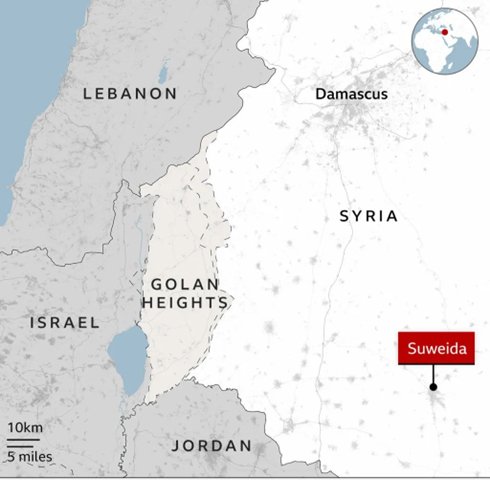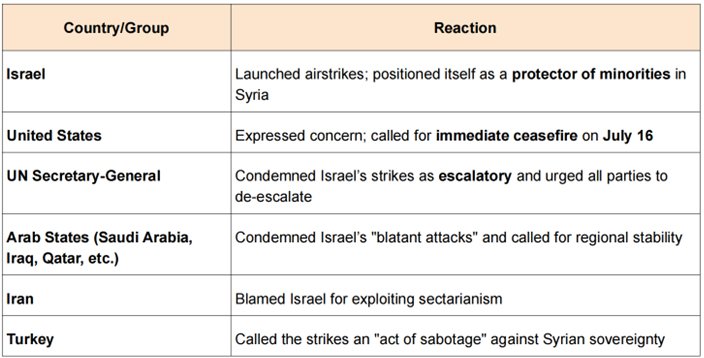BEDOUINS V/S DRUZE IN SYRIA
Why in News?
- A fresh wave of deadly sectarian violence has erupted in southern Syria, particularly in Suweida Province, where clashes between Druze militias, Sunni Bedouin tribes, and government forces have killed over 1,100 people in just one week.
- The violence, which began on Sunday, July 13, 2025, has prompted Israeli airstrikes on Syria and raised fears of wider regional escalation and sectarian fragmentation, especially as Syria’s new interim government struggles to establish control after the fall of Bashar al-Assad in December 2024.

WHO ARE BEDOUINS?
- The Bedouins are Arabic-speaking nomadic tribes who have historically inhabited the deserts of the Middle East and North Africa.
- The term “Bedouin” derives from the Arabic word “Badawi”, meaning “desert dweller”.
- Traditionally, Bedouins lived by herding camels, goats, and sheep, and moving seasonally across vast desert areas.
- In Syria, Bedouins are concentrated in the Al-Badia desert, spanning the provinces of Sweida, Homs, and Deir ez-Zor.
- Their population in Syria was estimated at over one million before the civil war.
- Tribes such as the Ruwallah of the Anizzah confederation are among the most prominent.
- While often marginalized politically, they maintained control over grazing lands, trade routes, and had considerable local influence
WHO ARE THE DRUZE?
- The Druze are an Arabic-speaking ethno-religious minority, found mainly in Syria, Lebanon, Israel, and the Israeli-occupied Golan Heights.
- Their religion is a monotheistic offshoot of Shia Islam, but incorporates elements of Greek philosophy, Gnosticism, and Hinduism, making it distinct.
- Around 500,000 Druze live in Syria, where they make up roughly 3% of the population, mostly in the Sweida region (Jabal al-Druze).
- In Syria, the Druze enjoyed limited autonomy under the Assad regime, managing their own local militias and civil affairs.
- Since Assad’s fall, Druze factions have resisted the integration of their militias into the national army and have objected to state security presence in their regions.
HISTORICAL RELATIONS
The Bedouin–Druze relationship in southern Syria has been marked by both cooperation and conflict over centuries.
Cooperation:
- Historically, the 2 groups shared economic ties: Bedouins provided salt, livestock services, and assisted in agriculture and transport, while Druze granted market access, water, and protection.
- Cultural exchanges were common; some Druze music and dances trace Bedouin origins, and Bedouins often gifted Arabian horses to Druze leaders.
- During the Great Syrian Revolt (1925–1927) against French colonial rule, both groups fought side-by-side.
Conflict:
- Under President Adib Shishakli in the 1950s, Bedouins were incited to attack Druze villages, resulting in looting and displacement.
- In 2000, a land dispute led to a Druze death at the hands of a Bedouin tribesman, sparking protests and government violence against Druze demonstrators.
- Despite shared grievances, relations often turned sour over land rights, political alliances, and competition for influence.
WHY HAS VIOLENCE ERUPTED AGAIN?
Immediate Trigger:
- The current conflict began on July 13, 2025, when a Druze merchant was abducted, allegedly by Bedouin fighters.
- The situation quickly escalated into retaliatory kidnappings, street battles, and sectarian killings.
Broader Causes:
- Collapse of Assad’s Regime:
- After Assad’s fall in December 2024, an interim government led by former militant Ahmed al-Sharaa dissolved local militias, including Druze defense groups.
- Many Bedouin tribes aligned with government and Islamist factions, increasing tensions in Sweida.
- Power Vacuum and Security Breakdown:
- The absence of unified control has led to militia-led governance, competing for territory and influence.
- Government forces, when deployed, were accused by Druze militias of committing atrocities, including summary executions and looting.
- Israeli Military Intervention:
- On July 15–16, Israel conducted airstrikes on Damascus, Suweida, and Deraa, stating it aimed to protect Druze civilians.
- Israel also struck the Ministry of Defence and Syrian Army HQ, marking its largest escalation since December 2024.
- Israel declared the creation of a de facto demilitarized zone near the Golan Heights, citing threats from Islamist fighters and pro-government militias.
- International Skepticism:
- While President Sharaa vowed to protect minorities, Israel and international observers remain skeptical, citing the recent killings of Alawites, among other minority abuses.
GLOBAL REACTIONS

WHAT COULD HAPPEN NEXT?
- The violence has jeopardized Syria’s fragile transition, deepening sectarian rifts and weakening state legitimacy.
- The interim government’s capacity to reconcile with minorities like the Druze, Alawites, and Kurds will determine the success of state-building.
- Israel is expected to continue its military posture in the region to counter perceived threats, increasing the chances of cross-border escalation.
- The risk of a new civil conflict, this time along tribal and sectarian lines, is rising sharply.
Note: Connect with Vajirao & Reddy Institute to keep yourself updated with latest UPSC Current Affairs in English.
Note: We upload Current Affairs Except Sunday.

